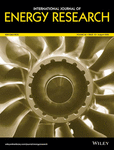Numerical investigation of turbulent flow across a SiC ceramic foam
Funding information: King Abdullah City for Atomic and Renewable Energy; King Fahd University of Petroleum and Minerals
Summary
A porous volumetric absorber in the solar thermal system is a promising utility for energy harvesting applications. The hydrodynamic behavior and thermal performance of porous structures in the absorber remain critical for efficient operation. Hence, in the present study, the assessment of SiC foam in a volumetric absorber is carried out for a concentrated solar energy harvesting system. In the numerical study, a 3D model of actual SiC foam is incorporated and the discrete ordinates radiation model, which is fully coupled with conduction and convection heat transfer, is adopted. A three-dimensional computed tomography scan (CT-scan) of porous SiC foam is imported for Computational Fluid Dynamics (CFD) modeling. The porous SiC absorber characteristics are examined for two working fluids including air and water. The overall thermal performance of the solar harvesting system is evaluated through the normalized Nusselt number and thermal efficiencies based on outlet and maximum temperatures. It is observed that utilizing porous SiC foam considerably improves the thermal performance of the solar harvesting system. A significant improvement is observed in the Nusselt number while demonstrating the convection is the apparent heating mode in the porous system, provided that the pressure loss of the channel with SiC foam is not substantially high.
Open Research
DATA AVAILABILITY STATEMENT
The authors confirm that the data supporting the findings of this study are available within the article. Any more information will be made available upon request.




